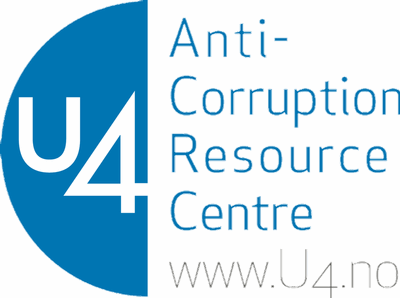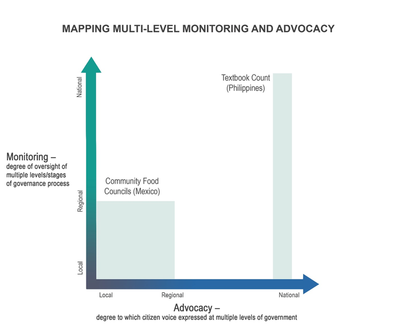How to do accountability differently through the vertical integration of civil society advocacy and monitoring

Vertical integration consists of coordinated, independent oversight of public sector actors across administrative levels and geographical areas in order to avoid illegal, inefficient or corrupt practices to merely move somewhere else to avoid detection. Donors can contribute to create opportunities for integrated strategies by improving coordination and targeting specific sectors.
In the August 2016 U4 Issue Doing accountability differently: A proposal on the vertical integration of civil society advocacy and monitoring, Joy Aceron, Jonathan Fox and Aránzazu Guillán Montero bring together academic, practitioner and policy perspectives on the value of vertical integration strategies to improve the results of civil society monitoring and advocacy, presenting evidence from the Textbook Count initiative in the Philippines.
Some important recommendations for donors are:
- Improve donor coordination to enhance the opportunities for more integrated civil society initiatives and jointly support initiatives that work across scale.
- Use sectors as critical entry points as they have a clear value chain with specific processes, actors and results.
- Facilitate policy dialogue, evidence and learning to better understand issues of scale and to strengthen the evidence-base on how scale matters for anti-corruption and accountability.
- Consider appropriate time frames and Measuring and Evaluation systems to track progress over time and adjust implementation when needed.
While the analysis clearly and accessibly develops and specifies the logic and implications of vertical integration for transparency, participation and accountability initiatives, the case study provides an in-depth discussion of its practical application to monitoring the whole chain of procurement, production, delivery and distribution of textbooks to local schools in the Philippines. The policy recommendations provide donors with some practical guidelines for supporting the vertical integration of civil society accountability initiatives.

Source: Jonathan Fox and Waad Tamaa in Fox and Halloran (2016), p. 6.
Civil society Initiatives to promote accountability that are restricted to only one locality or level of government (ignoring the whole process of decision making and implementation) are susceptible to the shifting of blame between different decision makers and to the adapting and migrating of pernicious practices to processes or regions where oversight is deficient. Vertically integrated strategies go beyond “scaling up” or merely reproducing initiatives. They aim at “connecting the dots” by
linking citizen action at the grassroots with action at the national level, while seeking to broaden […] “coverage” horizontally in terms of geographic and social inclusion of excluded citizens. Multi-level citizen oversight initiatives can gain additional traction if the evidence they produce manages to trigger public checks-and-balances institutions of horizontal accountability.
The Philippine civil society organization G-Watch developed the Textbook Count initiative with the objective of ensuring that the right quantity and quality of textbooks properly reached public school students at the right time.
In a context of systemic corruption, plagued with leakages and poor quality and undelivered textbooks, Textbook Count combined civil society engagement and coordination with reform champions in the Department of Education at the national level, with the mobilization of membership organizations such as the Boys and Girls Scouts of the Philippines in order to oversee the complete process of procuring, producing, and delivering the books.
Evaluations estimated that the initiative produced savings of around US$3.6 in 2007, and that for each Philippine peso invested in the initiative almost 4 pesos were not wasted, a fourfold return on the investment on the project’s investment.

Full vertical integration—overseeing a complete public program from the procurement of the public good to the delivery to the citizens and users, through production, quality control, following multiple levels of government and localities—is a highly ambitious goal. However, even partial integration, covering some of the stages of decision-making and implementation, can bolster citizen leverage and voice. Vertical integration can, in this way, take many forms, coordinating at different administrative levels and with varying regional scopes.
Vertical integration strategies combine monitoring and advocacy in multiple ways to foster responsive and effective government performance. Textbook Count combined monitoring at national, regional and local levels pursued by civic organizations with the coordinating and advocacy role played by G-Watch at the national level. While monitoring permitted to identify problems and their sources, advocacy with the Department of Education allowed to find and implement proper responses.
In contrast, Mexico’s experience with Community Food Councils relied on monitoring to inform advocacy from the village to the regional level in an effort to improve government performance in the delivery of staple foods to rural communities.

Vertical integration strategies face challenges. These challenges include the sustainability of the initiatives’ achievements in the long term; the trade-offs between maintaining independence and collaborating with government and between adversarial and collaborative strategies; and the differences and tensions within civil society coalitions—with some organizations focused on policy oriented advocacy at the national level and others responsible for membership representation at the grassroot level.
In the Philippines, for example, several factors threatened the sustainability of the Textbook Count initiative: a changed political context left the initiative without clear government champions; the end of donor funding; and the decision of G-Watch to move on to other projects (some of them pursuing further vertical integration strategies) given the demand for monitoring initiatives for other public services, among others.
Some key lessons of Textbook Count are:
- The initiative identified a previously invisible weak link –in the “last mile” of delivery of textbooks—and persuaded policymakers to address the causes and not just the symptoms of failures
- Even in collaborative partnerships with government, policy monitoring requires an independent civil society
- Partnerships with civic organizations--like the scouts-- can be a great strength but can have limitations in the long term
- Constructive engagement can produce substantive results under the right conditions—including senior policymaker allies and donor support—but presents limitations in terms of sustaining themselves in the long term and making results permanent
By combining monitoring and advocacy at multiple levels, vertically integrated monitoring and advocacy initiatives have the potential to: identify problems in policy implementation; identify the causes and not merely the symptoms of policy failure; generate pressures to obtain government responses; and promote the accountability of government institutions.
Donors should be aware of the advantages of taking scale into account when supporting civil society initiatives for anti-corruption. Funding decisions can influence the capacity of civil society initiatives to connect across scale and reach a higher degree of articulation. Considering multiple actors in multi-scale campaigns can promote a better balance between coalition participants, helping to keep the focus in the objectives of the project.
Further reading
Interview with one of the authors
A Conversation with Prof. Jonathan Fox on Doing Accountability Differently
U4 Brief. Frédéric Boehm. 2014. Mainstreaming anti-corruption into sectors: Practices in U4 partner agencies.
U4 Practice Insight. Karen Hussmann and Hady Fink. 2013. Addressing corruption through sector approaches: Exploring lessons from the Moroccan anti-corruption strategy for the health sector.
U4 Issue Paper. Jillian Clare Kohler and Natalia Ovtcharenko. 2013. Good governance for medicines initiatives: Exploring lessons learned.
U4 Practice Insight. Aránzazu Guillán, Renzo Lavin and Carolina Cornejo. 2013. When Supreme Audit Institutions engage with civil society: Exploring lessons from the Latin American Transparency Participation and Accountability Initiative.
U4 Anti-Corruption Centre and Developmental Leadership Program. Heather Marquette Caryn Peiffer. 2015. Corruption and collective action.
The U4 Anti-Corruption Resource Centre is part of the Chr. Michelsen Institute in Norway.
Publication
